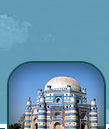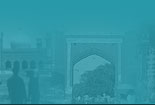|
Legend has that it was
founded by two sons of Lord Rama about 4000 years ago. Historically
it has been proved that Lahore is about 2000 years old. Hieun-tsang,
the famous Chinese pilgrim, has given a vivid description of Lahore
city which he visited in the early parts of the seventh century
A.D.
For
200 years, beginning from about 1525 A.D., Lahore was a thriving
cultural center of the great Mughal Empire. Mughal Emperors beautified
Lahore with palaces, gardens and mosques. During the British regime
many monuments sprang up in Lahore which blended beautifully with
the Mughal, Gothic and Victorian styles of architecture.
Lahore
is the second largest city in Pakistan and provincial capital
of Punjab. Apart from being the cultural and academic center of
the country, Lahore is the Mughal "show-window" of Pakistan.
The origins of Lahore are shrouded in the mists of antiquity.
Reminiscence of its hoary past are the remains of a subterranean
temple in the northern part of the Royal fort, attributed to Lord
Rama, the legendry hero of Ramayana. Lying on the main trade and
invasion routes to the sub-continent, Lahore has been ruled and
plundered by a number of dynasties and heroes. However it touched
the zenith of its glory during the rule of Mughals. The Mughals,
who were famous as builders, gave Lahore some of its finest architectural
monuments that are extinct today.
APPROACH:
Lahore is linked with the rest of the country by air,
rail and road. It lies on the Grand Trunk Road or the Shahrah-e-Aazam,
which connected Kabul with Calcutta. The road was originally built
by the Afghan ruler Sher Shah Suri in the 16th century. The Mughals
also used this road as means of communications. One can cross
over to India at Wahga, which is about 24kms east of Lahore.
PLACES
OF INTEREST:
The most important historical monuments of the Mughals in Lahore
are the Royal Fort, the Badshahi mosque, the Tombs of Emperor
Jehangir, Empress noor Jehan, Anarkali and Asif-Jah and the famous
Shalimar garden.
ROYAL
FORT LAHORE:
Although most parts of the Royal Fort were constructed around
1566 A.D. by the Mughal Emperor, Akbar the great, there is evidence
that a mud fort was in existence here in 1021 A.D. as well, when
mahmood of Ghazna invaded this area. Akbar demolished the old
mud fort and constructed most of the modern Fort, as we see it
today, on the old foundations. Construction of the fort dates
back to the early Hindu period.
The
Royal Fort is rectangular. The main gates are located alongside
the center of the western and eastern walls. Every succeeding
Mughal Emperor as well as the Sikhs, and the British in their
tom, added a pavilion, palace or all to the Fort. Emperor Jehangir
extended the gardens and constructed the palaces that we see today
in the Jehangir's Quadrangle, while Shah-Jehan added Diwan-e-Khas,
Moti Masjid (Pearl Mosque) and his own sleeping Chambers.Aurangzeb
built the impressive main gate which faces the Hazoori Bagh lying
in between the Badshahi Mosque and the Fort. The famous Sheesh
Mahal or palace of mirrors, is in the north-east corner of the
Fort. This is the most beautiful palace in the Fort and is decorated
with small mirrors of different colors set.
The
part of the wall of the Elephant Steps towards the Fort's inner
gate are scarred by bullet marks, bearing testimony to the Sikh
Civil War of 1847 A.D.
A
party of Sikhs had mounted their guns on one of the minarets of
the mosque across the courtyard from where they fired on their
opponents. The Sleeping Chamber of Mai Jindan houses a very interesting
museum with relics from Mughal and the Sikh periods.
Shalimar Gardens:
Three miles east of Lahore are the famous Shalimar Gardens laid
out by the Mughal EperorShah-Jehan in 1642 A.D. The Gardens are
spread out in typical Mughal style and are surrounded by high
walls with watch-towers at the four corners. Originally, the gardens
were spread over seven ascending terraces, but only three remain
now which cover an area of about 42 acres. The brick-work of the
floors of the three terraces have been repaired according to their
original designs which differ on all three terraces. There is
a marble pavilion under which water flows and cascades down over
a carved, marble slab creating a water-fall effect. Across the
water-fall is a marble throne. At the end of the second terrace
is a beautiful structure called Sawan Bhadon, a sunken tank niches
on its three sides. Water cascades down from it in sheets in front
of the niches, producing the sound of falling rain. In the olden
times, small oil lamps were placed in the niches which reflected
myriad colors, through the water. Similar gardens have the proud
privilege of being the stage of all important state receptions.
Minar-e-Pakistan:
Minar-ePakistan is a new landmark in Lahore and stands
in the Iqbal Park to commemorate the date when a resolution was
passed there back in 1940 demanding the creation of a separate
homeland for the Muslims of this sub-continent. The Minar is a
blend of Mughal and modern architecture and has been very boldly
designed. The Minar is about 60 meters tall.
Kim's
Gun or Zamzama:
Immortalized by Rudyard Kipping in his accounts is this
famous gun now popularly known as the Kim's Gum. It is placed
just outside the museum on the Sharah-e-Quaid-e-Azam in front
of the campus.
Wazir
Khan's Mosque:
In the old part of the town and off the Kashmiri Bazaar,
reputedly the most beautiful Mosque in the sub-continent is situated.
The Mosque was built in 1683 A.D. by Hakim Ilmuddin who was Minister
to Shah-Jehan and was generally known as Wazir Khan. It is a marvelous
specimen of tile work and arabesque paintings.
Badshahi
Mosque:
The emperor or the Badshahi Mosque is across the courtyard from
Alamgiri Gate of the Lahore Fort. The Mosque which is made up
entirely of sand-stone was built by Emperor Aurangzeb, the last
of the great Mughals, in a record time of the two and-a-half years.
Its construction was completed by 1674 A.D. It has a beautiful
gate-way which measures 21.33 meters in length and a courtyard
that measures 161.5 x 160.6 meters and is said to be the largest
mosque courtyard in the world for outdoor prayers.
The marble domes cover seven prayer chambers. For lofty minarets
stand at the four corners of the mosque, each with an outer circumference
of 20 meters, soaring up to 54 meters. In the chambers above the
gate of the mosque, are housed relics attributed to the Holy Prophet
of Islam peace be upon him, His Daughter and His Son-in-Law and
are said to have been brought to the sub-continent by Amir Taimur.
Within the Mosque almost all the colors have been used for painting
the floral designs but the overall effect remains one of sobriety,
piousness and simplicity.
The Golden Mosqeu:
Golden Mosque is also situated in the Kashmiri Bazaar.
It was built in 1753 A.D.by Nawab Syed Bhikari Khan, who was Deputy
Governor of Lahore.It is a remarkably beautiful mosque with three
golden domes.
Samadhi
of Maharaja Ranjeet Singh:
The ashes of the great Sikh ruler of Punjab, Maharaja Ranjeet
Singh, and of his four wives and several slave girls lie in a
dome adjacent to the Hazoori Bagh.
Other moments include the Dai Anga Mosque, Mariam Zamani Mosque
and various shrines of Muslim Sufi Scholars and saints and the
tomb of Allama Muhammad Iqbal near Badshahi Mosque.
Shrine
of Data Sahib:
Close to the junction of the Lower Mall and the Circular Road
is the shrine of Data Sahib was a great sufi saint whose well
known work, "Kashf-ul-Mahjub" has been translated from
the original Persian into several European languages and is considered
a classic. Attached to the Shrine is a beautiful mosque.
Allama
Iqbal's Tomb:
Outside the Badshahi mosque, near its steps, lies the tomb of
Allama Iqbal, the poet-philosopher of the East. The mausoleum
is a mixture of Afghan and Moorish style of architecture and is
constructed entirely of red sandstone which was quarried and brought
from Rajasthan.
Mausoleum
of Emperor Jehangir:
The tomb of the fourth great Mughal Emperor, Jehangir, lies three
miles north-west of Lahore across the river Ravi. It has a majestic
structure made of red sand-stone and marble. The outer entrance
to the tomb opens out into a court-yard which was used as a caravan
serai during Mughal times. An etrance to the right leads into
a Mughal garden with exact geometrical patterns balancing each
side. The marble tomb is approached from four corridors leading
from the garden. three of these corridors are closed by intricate
marble screens. The marble grave is elaborately inlaid with floral
designs and the 99 Attributes of God are inscribed on its two
sides. On the top is a verse from the Holy Quran. The tomb was
built by Queen Noor Jehan and the Emperor's son Shah-Jehan, around
1637 A.D.
Qutbuddin
Aibak's Tomb:
He was appointed Governor of India in 1191 A.D. by Muhammad Ghauri.
He established the slave Dynasty on the death of Muhammad Ghauri
in 1206 when he assumed independence of his reign and was followed
by nine other slave kings. He was a patron of the building art
and is known to have erected some monumental stone building in
Delhi and elsewhere. A very avid player of polo, he died in Lahore
in 1210 A.D. While playing the game. His tomb can be visited in
Anarkali Bazaar.
Asif
Khan's Mausoleum:
In the courtyard near Jehangir tomb lies buried his brother-in-law,
Asif Khan, father of Shah Jehan's beloved Queen Arjumand Bano.
He lies in a tomb which today shows little of its former splendor.
Nur
Jehan's Tomb:
The Empress Nur Jehan, "Light of the world" was the
only Empress whose name appeared on the coins of the Mughal empire.
She was buried in 1645 A.D. at Shahdara (Lahore) outside Jehangir's
mausoleum across the railway line.
Her
tomb once had a marble cenotaph which she had built herself during
her life time. After the decline of Mughal rule, the tomb suffered
extensive damages along with her husband's tomb at the hands of
Sikh marauders when they gained power during the early part of
nineteenth century. Both were stripped of most of its original
beauty and splendor. All treasure and tiles, it is said, were
carted off to decorate the Golden Temple at Amrita India.
Anarkali's
Tomb:
The tomb of Nadira Begum alias Anarkali, is situated in a corner
of the Civil Secretariat of Punjab Governent at Lahore.
The
tomb is circular in shape and rooted with a vast and lofty dome
supported from inside by eight massive arches 12 feet 3 inches
thick. It is a masterpiece of solid masonry work early Mughal
period and is neatly and beautifully fitted up.
Lahore
Museum:
Opposite the old University Hall, a Mughal style building
on the Shahrah-e-Quaid-e-Azam, houses the Lahore museum. The museum
contains some fine specimens of Mughal and Sikh door-way and wood-work
and has a big collection of paintings dating back to Indo-Pakistan,
Mughal, Sikh and British times. It has also a collection of musical
instruments, ancient jewellery, textile, poetry and armory. There
are relics from the Graeco-Pactrian times as well as some Tibetan
and Nepalese exhibits.
Faqirkhana
Museum:
A very large and interesting private Museum known as Faqirkhana
lies inside the Bhati Gate and is worth visiting. The museum houses
a variety of old paintings, including some by great masters, original
manuscripts in different languages and artifacts from South East
Asia and the Indo-Pak sub-continent.
Anarkali
Bazaar:
Anarkali bazaar is the most fascinating of the city's
many bazaars. The alleys and lanes of this bazaar are full of
exciting wares, especially traditional crafts like leather ware,
embroidered garments glass bangles, beaten gold and silver jewellery,
creations in silk. Any thing that you wish for a bargain.
Hiran
Minar:
Hiran Minar is set in peaceful evirons near Lahore. It
was constructed by Emperor Jehangir as a monument to Hansraj,
one of his pet antelopes. It is a popular picnic resort with a
lake and boating facilities.
Chhanga
Manga:
Chhanga Manga is a man-made forest 68 kms from Lahore. There is
a lake, and a miniature railway which winds its way through its
forest. Chhanga Manga has 12,510 acres of plantations. It is a
popular picnic spot spread over 50 acres with a lake and row boats,
motor boats, children's park, swimming pool, cafeteria, canteen
and rest houses.
Harappa:
The archaeological site of Harappa is 204 kms south of
Lahore. The town flourished at the time when the Indus valley
Civilization was at its zenith, about 4,500 years ago.
Jallo Park:
The Park is 28 kms from Lahore. It can be visited by
road and by rail. A rail-car leaves for Jallo Railway Station
every half hour. Spread over an area of 450 acres, it has expanses
of lawns, a forest research center, a children's park, zoo, a
small museum and a gift ship.
There
are four famous parks in Lahore namely:
-
Bagh-e-Jinnah Race Course Park, Gulberg Road.
- Gulshan-e-Iqbal Park, Allama Iqbal Town.
- Model Town Park, Model Town.
- Nawaz Sharif Park, Ferozepur Road.
These
parks have amusement avenues such as play lands for children,
mini zoos, aviaries and miniature lakes as well as peddle and
steamboats. Wahga Border:
This
check post is about 30 kms from Lahore and is the cross-over point
for travelers into India by the land route. It is open daily to
foreigners only (except Indian and Pakistani nationals) from 9:00
a.m. to 3:00 p.m. PST.
|





















